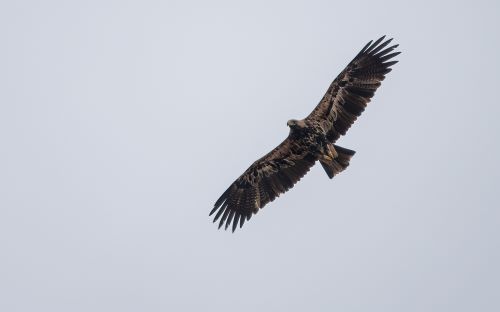
Eastern Imperial Eagle is a majestic species seen on this tour. Photo: Oli Reville
Located on the Black Sea, Bulgaria sits on one of Europe’s key bird migration flyways. Its varied habitats offer great variety - we can expect 150-200 species including Wallcreeper - as well as a rich overall natural history. We’ll also visit sites of history, mysticism, and legend, most revolving around one of the world’s most ancient civilisations, the Thracians. We’ll include three UNESCO world heritage sites.
This relaxed tour is designed for travellers looking for an experience combining culture and birds.
Day 1: The tour begins this evening in Sofia, the capital of Bulgaria. Night in a hotel at the foot of Vitosha mountain.
Day 2: We’ll visit Melnik, Bulgaria’s smallest town, famous for its geological and architectural features and its wine production. En route we’ll stop at the 10th century Rila monastery, a UNESCO world heritage site, and the ancient town of Herakleia Sintica with a history dating back to the 4th century B.C. Birds could include Long-legged Buzzard, Calandra Lark, and Olive-tree Warbler, and the area is also good for butterflies and reptiles. Night in Melnik.
Days 3-4: We’ll begin by driving to the lovely small village of Trigrad in the Rhodope mountains. Along the way we’ll have several birding breaks looking for Red-backed Shrike, Black-headed Bunting, and European Honey Buzzard among others. We’ll arrive late afternoon in Trigrad, perhaps with time to visit Devil’s Throat cave, nearby and famous in Thracian mythology as the location where Orpheus descended into the underworld.
On our second day we’ll explore the area around Trigrad Gorge, on the border with Greece. The steep-sided gorge is home to a strange subspecies of Black Pine which grows out of the bare rock without the need for any soil. While the beauty of the location is alluring, the primary reason for our visit is the mystical Wallcreeper, in its own bird family, the Tichodromidae, and one of the world’s most extraordinary birds. We’ll scan the cliffs in hopes of detecting this stunning bird. After lunch we’ll continue exploring the gorge and surrounds for Alpine Swift, White-throated Dipper, Ring Ouzel, and, with luck, Spotted Nutcracker. Nights in Trigrad.
Days 5-7: We’ll cross the Rhodope mountains on the way to the town of Krumovgrad in the Eastern Rhodopes, a vast and new environment being of volcanic origin, far less forested, and arid. Species we might encounter in the first part of our journey through the mountains include Black Stork, Lesser Grey Shrike, Eurasian Scops Owl, Rock Bunting as well as beautiful if more widespread species such as Common Firecrest and elegant Grey Wagtail.
Along our route we’ll visit the ancient town of Perperikon, an ancient settlement dating to 8000 B.C. and featuring buildings carved into the rocks. Perperikon holds the famous temple of Dionysius where it is said a prophecy that Alexander the Great would rule the world was delivered.
The following day we’ll explore the Studen Kladenets volcanic region with its beguiling and moon-like scenery. It is here that large birds of prey species are most numerous, and we’ll hope to connect with Griffon, Egyptian and Cinereous Vultures at close range at a site where they are fed a carcass to support them during the taxing breeding season. Other birds could include Short-toed Snake Eagle, Black-eared Wheatear, Woodchat and Masked Shrikes, Eastern Subalpine and Barred Warblers, and Crested Lark.
On our final day we’ll investigate the Dolna Kula valley. It’s more wooded than Studen Kladenets and the species mix is different, including almost all the warblers found in Eastern Europe. In addition, we’ll look for Blue Rock and Common Rock Thrushes, Cirl and Ortolan Buntings, Eurasian Golden Oriole, and European Roller. Nights in Krumovgrad or a nearby village.
Days 8-9: We’ll drive to the beautiful Black Sea coast and the ancient town of Sozopol from which we’ll explore the southern section of Bulgaria’s bird migration highway. On the way we’ll search in particular for Eastern Imperial Eagle and Isabelline Wheatear.
The next day we’ll explore the Pomorie saltpans and lakes around the city of Burgas, the most significant wetlands along the Bulgarian Black Sea coast and host to a huge range of species including Pied Avocet, Black-winged Stilt, Sandwich and Little Terns, Kentish Plover, Mediterranean Gull, Great Reed Warbler, Bearded Reedling, Little Bittern, Ruddy Shelduck, White-tailed and Lesser Spotted Eagles, and many migrant shorebirds, almost certainly including Curlew Sandpiper, and Little Stint. Night in Sozopol.
Days 10-11: We’ll continue north along the Black Sea. En route we’ll stop in ancient oak woodlands, at a known location for the localised Semicollared Flycatcher as well as Levant Sparrowhawk and Black and Middle Spotted Woodpeckers. Continuing north towards Kavarna, we’ll pause in Varna, the largest town on the Bulgarian Black Sea coast, where we’ll visit the archaeological museum which holds relics dating back to 4600 B.C., including the golden sceptre belonging to the Thracian rulers of the region.
The next day we’ll investigate the wild steppes of the Kaliakra reserve, starting at Durankulak Lake looking for Squacco Heron, Ferruginous Duck, Collared Pratincole, Paddyfield Warbler, and Red-footed Falcon. The nearby and beautiful 200-foot cliffs of Cape Kaliakra and the 2400-year-old fort on the cliff top have a significant Roman and Byzantine history, all of which will form a backdrop to our birding with possible Pied Wheatear, Greater Short-toed Lark, and Rosy Starling. From a picturesque restaurant on the cliff top we can watch Bottle-nosed Dolphins and groups of Yelkouan Shearwaters moving along the coast. We’ll finish the day with a search for the mighty Eurasian Eagle-Owl. Nights in Kavarna.
Days 12-14: We’ll travel to the Srebarna Nature Reserve, yet another UNESCO world heritage site offering superb birding with a great combination of waterbirds and woodland birds. The endangered Dalmatian Pelican is one of the key reasons for our visit, but other interesting species include Ferruginous Duck, and all the heron, bittern, and egret species that occur in Europe. In the evening we may also see the enigmatic Golden Jackal, the only species of jackal outside of Africa.
The next day we may have a morning session at a colony of stunning European Beeeaters. We’ll watch from a blind which should allow full appreciation of their rainbow-like array of colors. We’ll also visit important birding locations in the Sreburna reserve, notably the Maluk Preslavets Marsh, a fascinating area for birds and for flora, including the beautiful White Water Lily. We’re at the end of our tour and will have already seen many of the species we encounter but perhaps Montagu’s Harrier or Garganey will be new.
On our final day we’ll visit our last UNESCO World Heritage Site, the Thracian tomb of Sveshtari with its stunning murals. It’s 2300 years old and holds the tomb of Dromichaetes, a Thracian king who defeated Alexander the Great’s successor, Lysimachus. Nights at Pelican Birding Lodge, Vetren.
Day 15: We’ll drive to Bucharest, Romania where the tour concludes midday.
Updated: 25 August 2023
Prices
- 2024 Tour Price : $3,950
- Single Occupancy Supplement : $250
- 2025 Tour Price Not Yet Available
Notes

Questions? Tour Manager: Matt Brooks. Call 1-866-547-9868 (US or Canada) or (01) 520-320-9868 or click here to email.
* Tour invoices paid by check carry a 4% discount. Details here.
This tour is limited to 10 participants with two leaders.
